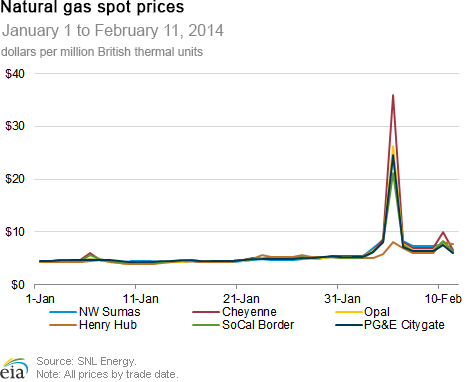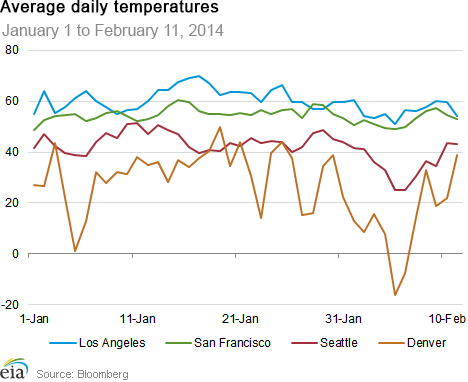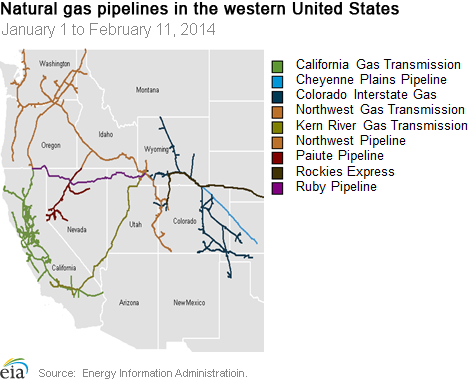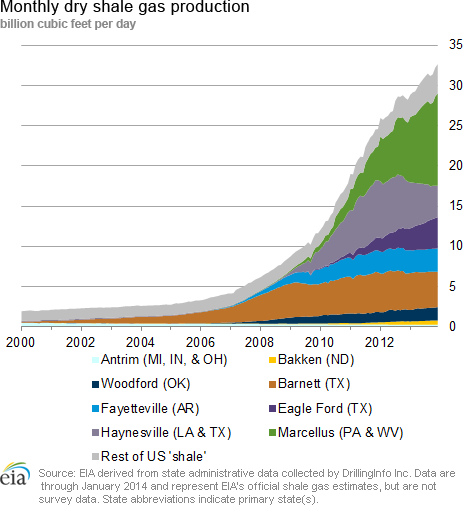In the News:
Reduced inflows strain California natural gas markets
Last Thursday, February 6, the California Independent System Operator (CAISO) issued an alert requesting that customers reduce electricity consumption on that day. The alert was in response to a natural gas shortage at Southern California power plants, but its conservation request applied to all consumers in the state.
Temperatures in San Francisco and Los Angeles averaged 50 and 57 degrees Fahrenheit, respectively, on February 6. Although these temperatures were 9% and 7% below the average for the previous 30 days, they were still well above temperatures in Denver (-8 degrees ) and Seattle (25 degrees ).
Natural gas deliveries to California were reduced by a combination of lower inflows on pipelines carrying in production from the Rockies, and decreased inflows on pipelines taking Canadian production south through the Pacific Northwest. These pipelines extend to California, but colder temperatures in the Pacific Northwest led customers there to take more natural gas off those pipelines, thus leaving less to flow into California. In addition, this led to an increase in spot prices to 10-year highs at many major western hubs. For California, this resulted in:
- The PG&E Citygate spot price for natural gas serving northern and central California consumers reaching a 10-year high on February 5 of $24.55 per million British thermal units (MMBtu), versus an average for the previous 30 days of $4.93/MMBtu, according to SNL Energy. Although consumption in the PG&E market area on February 6 rose 29% over its 30-day average to 3.9 billion cubic feet (Bcf), natural gas supplied to PG&E (predominantly pipeline inflows, with some local production) decreased to 1.1 Bcf, 38% below the 30-day average. Bentek Energy reported that storage withdrawals on February 6 totaled 2.8 Bcf, 127% above the 30-day average.
- Similarly, the Southern California Border spot price rose to a 10-year high on February 5 to $21.22/MMBtu, versus an average for the previous 30 days of $4.91/MMBtu. Consumption in Southern California rose by 23%, to 3.8 Bcf, while supply (again mainly pipeline inflows) declined by 30% below the 30-day average, to 1.9 Bcf. Storage withdrawals totaled 2.6 Bcf, 131% above the average for the previous 30 days, according to Bentek.
- Low inventories led to five consecutive days of operational flow orders on the California Gas Transmission (CGT) pipeline, from February 3 to February 8. This restricted pipeline customers from taking more gas off the pipeline than normal despite the colder temperatures.
Natural gas pipeline inflows to California and the Southwest (Arizona, Nevada, and New Mexico) decreased from both the Pacific Northwest and the Rockies. Much of the gas that flows from the Pacific Northwest into California comes on the Northwest Pipeline. Northwest flows Canadian production from the Westcoast Pipeline to consumers in the Pacific Northwest (Washington, Oregon, and Idaho), as well as to California consumers via its interconnections with CGT in Malin, Oregon, and the Paiute Pipeline on the Idaho-Nevada border. Northwest deliveries at Malin decreased to 0.4 Bcf on February 5, 60% below its 1.0 Bcf/d average for the previous 30 days. Inflows of Rockies production also decreased to Southern California on the Kern River Gas Transmission pipeline and to northern California on the Ruby Pipeline.
Overview:
(For the Week Ending Wednesday, February 12, 2014)
- Natural gas spot prices decreased at most trading locations during the report week, even as winter weather slammed much of the country. Though it declined overall, the Henry Hub spot price remained somewhat elevated through the report week, beginning the week at $7.90/MMBtu last Wednesday, February 7, and ending the report week at $6.15/MMBtu yesterday.
- At the New York Mercantile Exchange (Nymex), the March 2014 futures price decreased from $5.030/MMBtu last Wednesday to $4.822/MMBtu yesterday.
- Working natural gas in storage decreased to 1,686 Bcf as of Friday, February 7, according to the U.S. Energy Information Administration (EIA) Weekly Natural Gas Storage Report (WNGSR). A net storage withdrawal of 237 Bcf for the week resulted in storage levels 33.9% below year-ago levels and 27.2% below the 5-year average.
- The total rig count was down 13 from the previous week but up 12 from the same time last year, according to data released by Baker Hughes Inc. The natural gas rotary rig count totaled 351 as of February 7, a decline of 7 from the previous week and down 74 from the same week last year. The oil rig count was 1,416, a decline of 6 from the previous week but 86 rigs greater than the same time last year.
- The weekly average natural gas plant liquids composite price fell 0.6% this week (covering February 3 through February 7) compared to the previous week, and is now at $12.68/MMBtu. Propane spot prices at Mont Belvieu, Texas, rose 1.1% and the ethane price rose 2.4%. Butane and isobutane prices fell 3.4% and 5.9%, respectively, and natural gasoline prices declined by 1.9%.
Prices/Demand/Supply:
Natural gas prices remained high nationwide. The U.S. has faced bitterly cold weather over the past several weeks, and prices have remained elevated in response. This week, the Henry Hub spot price was greater than $7/MMBtu most days. A wave of cold at the beginning of the report week drove the day-ahead spot price to $7.90/MMBtu, a level not seen since September 2008. Natural gas prices had only been greater than $7/MMBtu a handful of times since September 2008, until this week. At the end of the week, the Henry Hub price had fallen to $6.15/MMBtu, which is still relatively high compared to sub-$4/MMBtu prices just a few months ago.
Northeast prices dropped. Most pricing points began the week above $10/MMBtu, but dropped throughout the week. A major winter storm hit much of the Mid-Atlantic on Wednesday night; however, prices continued to drop in the Northeast. At Transcontinental Pipeline's Zone 6 trading point for delivery into New York City (which was expected to receive about a foot of snow on Thursday), prices declined almost $13/MMBtu from Tuesday to Wednesday ($20.74/MMBtu to $7.80/MMBtu.) Similarly, at Texas Eastern Transmission's M-3 trading point, which serves Mid-Atlantic customers in New Jersey and Pennsylvania, prices fell more than $10/MMBtu from Tuesday to Wednesday ($17.50/MMBtu to $6.96/MMBtu). Declines were similar in Boston and other major market areas in the Northeast.
Price declines seemed counterintuitive. Some analysts quoted in the trade press attributed the price declines to a lack of demand caused by the storm. While residential demand will increase, overall demand could fall because of closed schools, businesses, and office buildings. In its daily Northeast Observer report, Bentek Energy projected a 22% decline in demand in the Northeast from 34.3 Bcf Wednesday to 26.9 Bcf on Thursday.
Before it hit the Northeast, the storm covered much of the South with snow and ice. Storms hit Georgia and the Carolinas on Wednesday. In an update, the National Weather Service noted that ice accumulations would be "mind-boggling if not historical." Natural gas spot prices in the Southeast were mostly between $7 and $8/MMBtu on Tuesday. Earlier in the report week, cold weather in Texas boosted consumption of natural gas for power generation (power burn); power burn rose 45% from the previous week and was 73% greater than the same week last year. Texas is one of the major consuming regions of natural gas for power generation, after the Northeast and Southeast.
Imports rose to meet demand. This week, U.S. natural gas imports from Canada rose 5.0% from the previous week, according to data from Bentek. Imports are 22.8% greater than the same week last year. While U.S. natural gas imports in general have declined over the past several years, they still are an important source of supply in times of high demand. This has been particularly true this winter. LNG sendout, while small, has also risen this winter, with supplies this week coming from the Elba Island terminal in Georgia and the Everett terminal in Massachusetts.
Natural gas production declined. This week, dry production fell 0.5% from the previous week (though it is 0.7% greater than the same week last year). While dry production remains at historically high levels, and is still greater than last year, the winter weather has hindered production. In its earnings call last week, Chesapeake Energy, a major producer of natural gas in the United States and very active in the Marcellus Shale, noted that oil and gas output were well below expectations as a result of the cold weather.
U.S. consumption rose 15.7% this week. Increases in U.S. demand this week were evident by a 19.6% increase in power burn and a 17.6% increase in residential and commercial consumption as cold weather led to increases in heating demand. Industrial consumption, which is also sensitive to weather but to a lesser degree than residential and commercial, rose by 4.3%, according to Bentek data. In Bentek's eight-year history, the six highest days of total consumption all fell in January and February this year; February 6 was the fifth-highest value.
Futures prices declined. Bullish activity in the past several weeks has been much more apparent in spot markets, as buyers and sellers responded to short-term weather fluctuations rather than changes on the Nymex. The Nymex price has been elevated, but has not reached anywhere close to the $7/MMBtu spot price mark. The March 2014 contract fell from $5.030/MMBtu last Wednesday to $4.822/MMBtu yesterday. The price of the 12-month strip (the average of the contracts between March 2014 and February 2015) declined from $4.614 last Wednesday to $4.597/MMBtu yesterday, with most of the activity concentrated in the near-month contract.
Storage
Cooler weather drives another larger-than-average net withdrawal. The net withdrawal reported for the week ending February 7 was 237 Bcf, 75 Bcf larger than the 5-year average of 162 Bcf and 85 Bcf larger than last year's net withdrawal of 152 Bcf. Working gas inventories totaled 1,686 Bcf, just 3 Bcf more than last year's season-ending value of 1,683 Bcf on March 31, 2013. Current inventories are 863 Bcf (33.9%) less than last year at this time, 631 Bcf (27.2%) below the 5-year (2009-13) average, and 331 Bcf (16.4%) below the 5-year minimum.
Storage draw greater than market expectations of 232 Bcf. When the EIA storage report was released, the price for the March natural gas futures contract increased a few cents on the Nymex. At 10:30 a.m., the price of the near-month (March 2014) contract rose to $4.96/MMBtu. Prices climbed to just over $5.00 in the hour following the release.
Net withdrawals in all three regions larger than average. The East, West, and Producing regions had net withdrawals of 106 Bcf, 42 Bcf, and 89 Bcf, respectively. All three gas storage regions remain below their year-ago, 5-year average levels, and 5-year minimums.
Temperatures during the storage report week cooler than normal. Temperatures in the Lower 48 states averaged 30.3 degrees for the week, 4.3 degrees cooler than the 30-year normal temperature and 3.9 degrees cooler than during the same period last year.
See also:
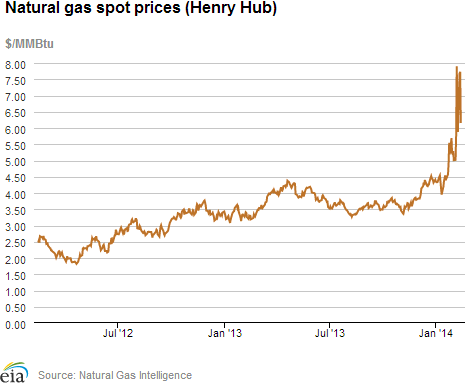
| Spot Prices ($/MMBtu) | Thu, 06-Feb |
Fri, 07-Feb |
Mon, 10-Feb |
Tue, 11-Feb |
Wed, 12-Feb |
|---|---|---|---|---|---|
| Henry Hub |
7.01 |
5.88 |
7.68 |
7.73 |
6.15 |
| New York |
18.10 |
12.38 |
20.33 |
20.74 |
7.80 |
| Chicago |
9.09 |
12.23 |
15.49 |
8.22 |
6.25 |
| Cal. Comp. Avg,* |
7.46 |
6.69 |
7.79 |
6.21 |
5.42 |
| Futures ($/MMBtu) | |||||
| March Contract |
4.931 |
4.775 |
4.579 |
4.824 |
4.822 |
| April Contract |
4.562 |
4.516 |
4.406 |
4.570 |
4.553 |
| *Avg. of NGI's reported prices for: Malin, PG&E citygate, and Southern California Border Avg. | |||||
| Source: NGI's Daily Gas Price Index | |||||
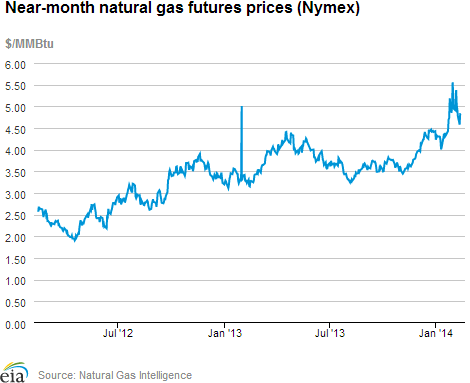
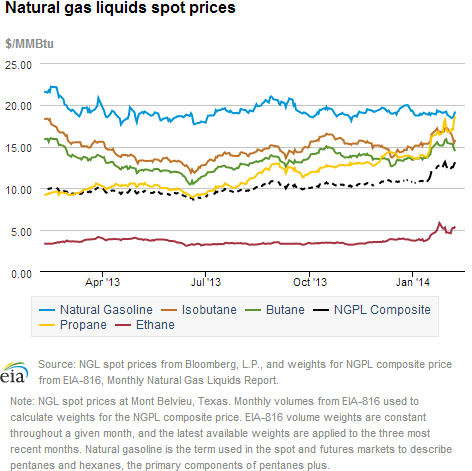
| U.S. Natural Gas Supply - Gas Week: (2/5/14 - 2/12/14) | ||
|---|---|---|
Percent change for week compared with: |
||
last year |
last week |
|
| Gross Production | 0.70%
|
-0.50%
|
| Dry Production | 0.70%
|
-0.49%
|
| Canadian Imports | 22.76%
|
5.02%
|
| West (Net) | 10.08%
|
-9.79%
|
| MidWest (Net) | 81.29%
|
22.02%
|
| Northeast (Net) | -6.29%
|
15.80%
|
| LNG Imports | 37.58%
|
66.92%
|
| Total Supply | 2.50%
|
0.24%
|
| Source: BENTEK Energy LLC | ||
| U.S. Consumption - Gas Week: (2/5/14 - 2/12/14) | ||
|---|---|---|
Percent change for week compared with: |
||
last year |
last week |
|
| U.S. Consumption | 30.6%
|
15.7%
|
| Power | 21.7%
|
17.7%
|
| Industrial | 8.4%
|
4.3%
|
| Residential/Commercial | 45.1%
|
19.6%
|
| Total Demand | 30.1%
|
15.4%
|
| Source: BENTEK Energy LLC | ||
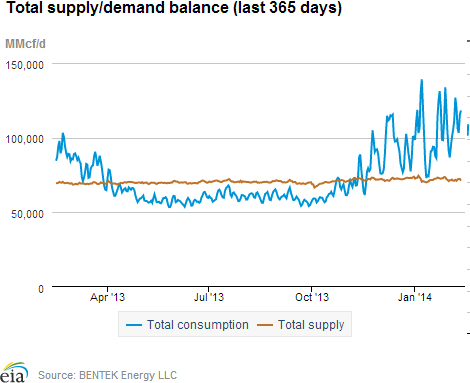
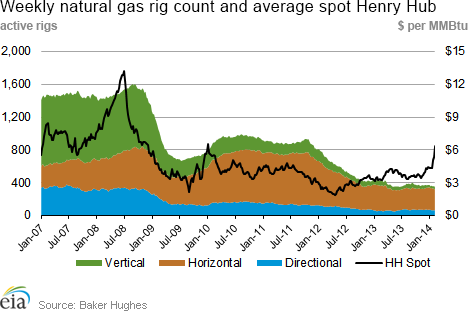
| Rigs | |||
|---|---|---|---|
Fri, February 07, 2014 |
Change from |
||
last week |
last year |
||
| Oil Rigs | 1,416 |
-0.42% |
6.47% |
| Natural Gas Rigs | 351 |
-1.96% |
-17.41% |
| Miscellaneous | 4 |
-20.00% |
0.00% |
| Rig Numbers by Type | |||
|---|---|---|---|
Fri, February 07, 2014 |
Change from |
||
last week |
last year |
||
| Vertical | 389 |
-0.77% |
-9.74% |
| Horizontal | 1,176 |
0.26% |
2.89% |
| Directional | 206 |
-6.36% |
11.35% |
| Source: Baker Hughes Inc. | |||
| Working Gas in Underground Storage | ||||
|---|---|---|---|---|
Stocks billion cubic feet (bcf) |
||||
| Region | 2014-02-07 |
2014-01-31 |
change |
|
| East | 814 |
920 |
-106 |
|
| West | 259 |
301 |
-42 |
|
| Producing | 613 |
702 |
-89 |
|
| Total | 1,686 |
1,923 |
-237 |
|
| Source: U.S. Energy Information Administration | ||||
| Working Gas in Underground Storage | |||||
|---|---|---|---|---|---|
Historical Comparisons |
|||||
Year ago (2/7/13) |
5-year average (2009-2013) |
||||
| Region | Stocks (Bcf) |
% change |
Stocks (Bcf) |
% change |
|
| East | 1,204 |
-32.4 |
1,129 |
-27.9 |
|
| West | 381 |
-32.0 |
343 |
-24.5 |
|
| Producing | 965 |
-35.8 |
845 |
-27.5 |
|
| Total | 2,549 |
-33.6 |
2,317 |
-27.2 |
|
| Source: U.S. Energy Information Administration | |||||
| Temperature -- Heating & Cooling Degree Days (week ending Feb 06) | ||||||||
|---|---|---|---|---|---|---|---|---|
HDD deviation from: |
CDD deviation from: |
|||||||
| Region | HDD Current |
normal |
last year |
CDD Current |
normal |
last year |
||
| New England | 248
|
-23
|
-7
|
0
|
0
|
0
|
||
| Middle Atlantic | 257
|
-3
|
-10
|
0
|
0
|
0
|
||
| E N Central | 332
|
45
|
10
|
0
|
0
|
0
|
||
| W N Central | 388
|
91
|
85
|
0
|
0
|
0
|
||
| South Atlantic | 163
|
-12
|
-19
|
13
|
6
|
11
|
||
| E S Central | 183
|
6
|
3
|
0
|
0
|
0
|
||
| W S Central | 165
|
39
|
78
|
1
|
-3
|
-3
|
||
| Mountain | 271
|
53
|
86
|
0
|
-1
|
0
|
||
| Pacific | 143
|
33
|
52
|
0
|
0
|
0
|
||
| United States | 245
|
30
|
29
|
2
|
0
|
2
|
||
|
Note: HDD = heating degree-day; CDD = cooling degree-day Source: National Oceanic and Atmospheric Administration | ||||||||
Average temperature (°F)
7-Day Mean ending Feb 06, 2014
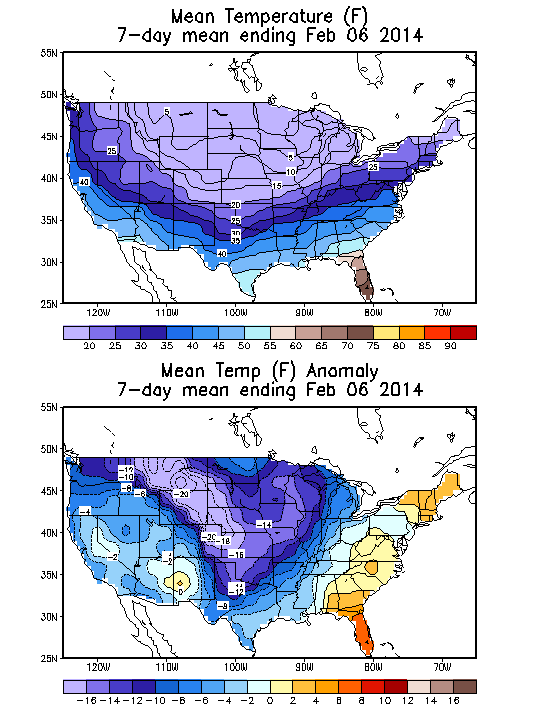
Source: NOAA/National Weather Service
Deviation between average and normal (°F)
7-Day Mean ending Feb 06, 2014

Source: NOAA/National Weather Service

